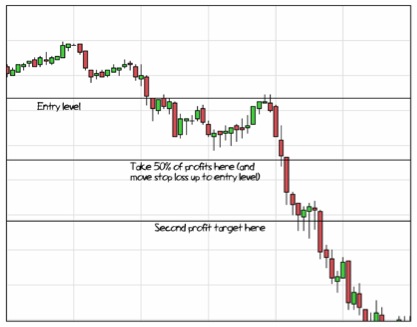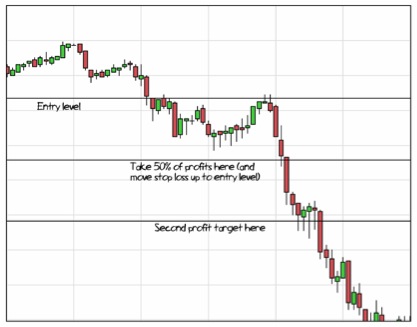 Having your cake and eating it
Having your cake and eating it
The technique I’m going to talk about today is called taking partial profits.
And it’s a great way to deal with the “Should I? Shouldn’t I?” feeling that we all get when we’re nearing our profit targets.
How the partial profits method works
The way it works is that you set yourself more than one profit target – taking part of your profits at one level, and leaving some money on the table to potentially reach the higher profits.
Partial profits can be hugely beneficial to the trader. This technique can help to limit your risk and heighten your confidence.
It can increase your percentage of winning trades, and can enable you to catch future price movements and benefit from them.
On the downside, taking partial profits can leave you exposed to future downside – which is why it is a technique often applied in conjunction with moving your stop loss in tighter.
Applying the technique
It works something like this…
When I enter my trade, I set myself two different profit targets. At the first I’ll take 50% of my profits. For the remaining 50% of my stake, I’ll leave that to run to my second profit target, with a stop loss moved in to my entry level.

As you can see, in this example, we’ve managed to secure a profit from the first move of 35 points. We’ve then protected 50% of that profit by closing out half of the trade. The market then continued to move in our favour, so the second half of the trade ran for a further 35 points.
By also moving in our stop loss to the entry level, we can protect the second half of our trade from losses (worst case scenario is that this results in a breakeven trade).
In this second example, the market retraces and knocks out the second half of our trade…

Here, we’ve secured profits at our first profit target, but the price then fell back, meaning the second half of my trade closed out at breakeven, failing to reach the second profit target.
Of course, there are no rules about how much you close out at the first level – it could be 50%, 30%, 20% – whatever suits your plan. Remember, the less you close out, the more aggressive you are being.
Likewise, there’s no rule that you should move your stop loss up to the entry level – this level may not be the best place, and you may prefer to leave it where it is or select a different level based on support/resistance levels.
Taking partial profits won’t necessarily make your long-term trading more profitable – it gives us the security of knowing we’ve some profits secured, and this security usually comes at a price. However, by boosting your percentage of winning trades, it can help you to maintain a positive attitude to your trading – the importance of which shouldn’t be underestimated.
The third piece of our jigsaw
Last time we took a look at what makes up a successful strategy…
It’s the set-up
AND it’s having a good entry.
What we didn’t consider is having a good exit.
Knowing when and how you’re going to get out of your trade is just as important as how you get into it – and can mean the difference between making a good profit, or taking a nasty hit.
If you have an intelligent method for scaling out of your trades, it can be a powerful addition to your trading strategy.
However, a few warnings before you begin applying partial profit-taking techniques…
1. Don’t use this technique as a license to fly by the seat of your pants and “see what happens”. Your multiple profit targets should be decided on as part of your strategy – not made up on the spur of the moment. And if the technical signals are telling you to close out at your first profit level – then close at that level.
2. If you’re opening and closing multiple orders, watch that you aren’t increasing your risk levels – don’t double up your risk just because you’re going to be closing out half of it early. (Remember, the trade can still go against you before you’ve reached your first profit target.)
3. While taking partial profits should increase the success rate you achieve with your trades, it won’t necessarily make your trading more profitable overall. Monitor the effect it is having on your trading – is it working for you?
It comes down to a balancing act – if you’re taking partial profits, you won’t make as much money as if you’d let your entire trade run to the second profit target. However, you will achieve a profitable result on some occasions when your second target isn’t hit (which would otherwise have been a losing trade).
For most of us traders – the way our brains are wired is that we don’t like losing. Losing runs are what can make us walk away from potentially profitable strategies. So, if there’s something we can do to boost our success rates – it could mean the difference between staying in the game, and throwing in the towel.

 Having your cake and eating it
Having your cake and eating it